Table of contents
Whether you’re marketing a brand new startup or a seasoned veteran, there’s no substitute for real customer feedback and research.
After all, you can’t market anything effectively if you don’t know who you’re selling to.
Customer research is such a crucial part of marketing that, when we asked survey respondents how important they considered customer research to be, nearly 93% rated it as “Very Important” or “Crucially Important.”
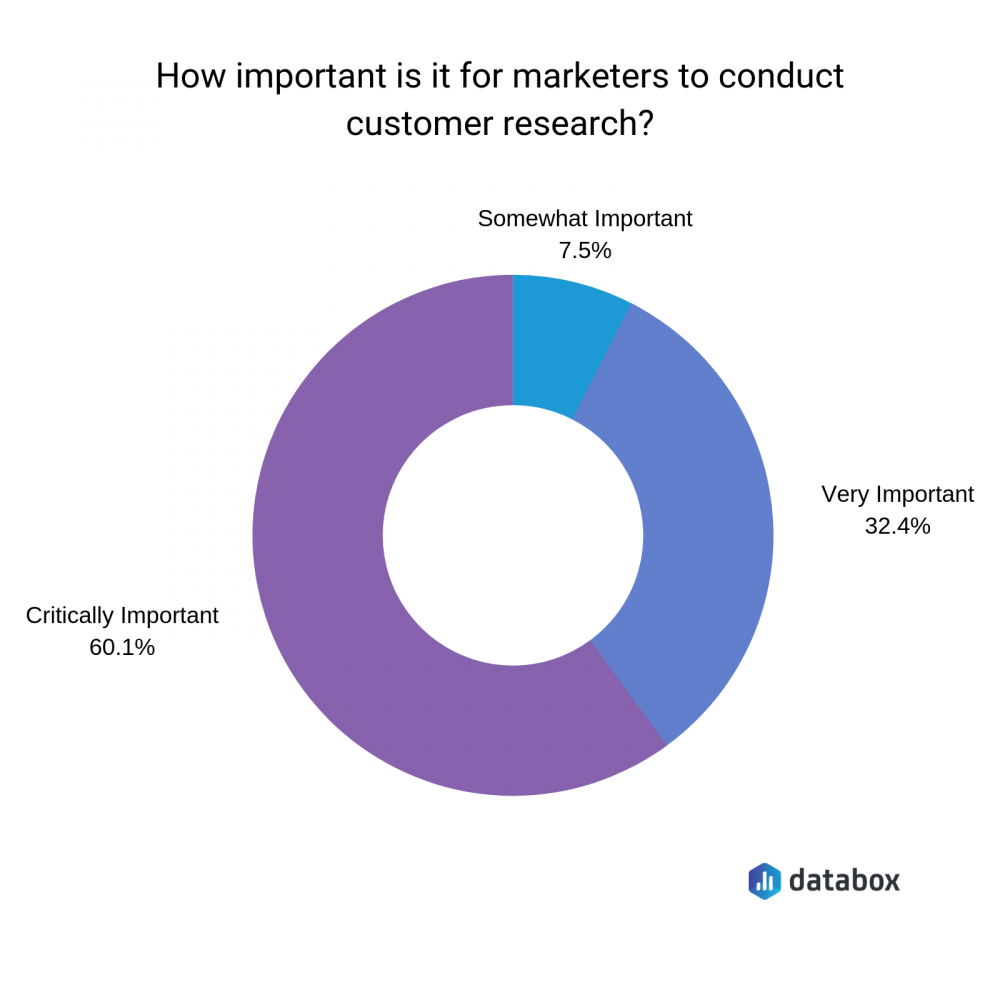
“Marketers need to conduct customer research at the very least annually. In order to sell to someone, you need to know their needs,” said Tim Brown of Hook Agency.
Brown’s comment got us thinking—if customer research is so important, how often are people doing it? When we asked those same marketers that question, we got some varied responses. But crucially, the majority skewed toward more often, with over 25% reporting quarterly customer research efforts and nearly 20% reporting they conduct customer research daily.

So what are marketers actually doing to conduct that customer research? When we asked our respondents about that, there were 4 clear winners that more than half of the marketers we spoke with reported using:
- Customer interviews
- Email surveys
- Analytics analysis
- Online research
But we also heard about many other creative ways to conduct customer research that we hadn’t thought of before.
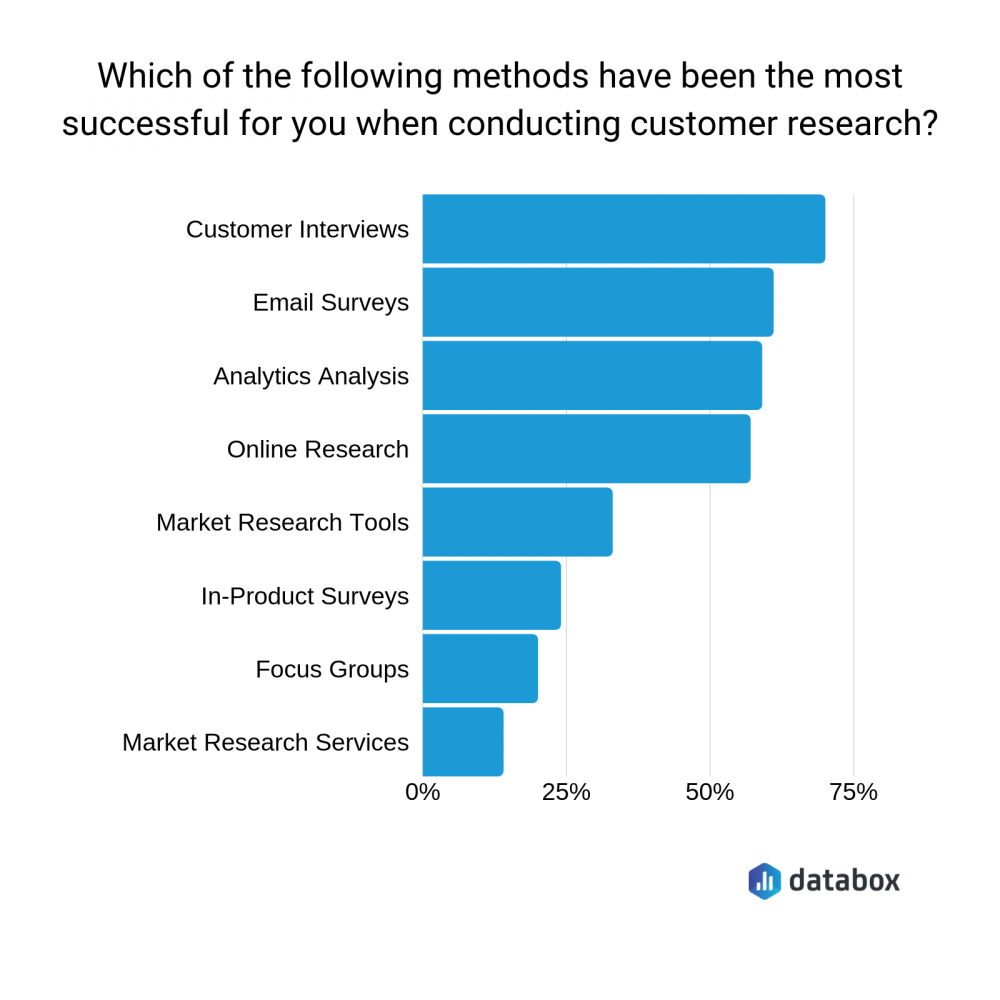
On that note, here are the 20 customer research methods marketers shared with us.
1. Leverage Existing Customer Reviews
Brian Jensen of Congruent Digital recommended turning to a familiar source for customer research: online reviews. “We used a tool called Apify to crawl and return all of our client’s reviews into a database. We then put into a text analysis tool to find the top keywords and phrases (attributes) customers used in their reviews.”
Jensen says they used this data to help improve the client’s messaging.
“Once we had the data and knew by occurrences what their customers enjoyed most about their experience, we updated ads and landing pages to better identify with the needs and expectations of prospects.”
2. Spend a Day in Your Customer’s Office
Phil Strazzulla of SelectSoftware shared another customer research method we hadn’t heard about before. Strazzulla recommended spending a full day, in-office with your customer, saying “This allows me to have informal conversations with the key stakeholders I need to market to in order to better understand their challenges, goals, language, and personalities.”
“Simply reach out to a potential or current customer and ask if you can work from their space for a day,” Strazzulla explained. “And have as much free time as you can to walk around and talk to people in the office about what they do and how you can help them with your product.”
3. Turn to Data Analytics
Analytics analysis was one of the top 4 answers we heard—but it’s a broad term, so we were interested to learn more about what marketers do with analytics.
“When we do customer and product research, we start by understanding how customers are using the tool by looking at their data and usage, and then benchmarking it with their industry,” said Supratim Da Dam of CallPage. “This allows us to have a solid idea of how our customers are deploying our solution, the gaps, successes, blockers, and more.”
Robert Baillieul of Lombardi Publishing uses Twitter Analytics to identify topics and pains that resonate with their customers. “Anything that consistently generates engagement rates north of 5% indicates a huge pain point for your customer—sometimes issues they would never admit to out loud. You can then turn these insights into new products, services, or content.”
“We get data from many tools we’re using (email marketing, website analytics, social media, and more),” explained Jonathan Aufray of Growth Hackers. “With the help of a great data analyst and a tool like Google Data Studio, we can quickly analyze our customers.”
Vira Vielmann of Seventh Scout says they turn to social media analytics most often. “We typically utilize social media analytics to learn more about the audience engaging with us. This gives us an amazing insight into their demographics and interests. They also let us know what topics and posts are doing well and which aren’t performing the best, so we can adjust our strategy and editorial calendars as needed.”
4. Collect Customer Survey Responses
“My favorite way to get customer research is to send out an email survey,” James Pollard of The Advisor Coach said. “I keep it short (about five or six questions) and only ask them the questions that will have the biggest impact on my business.”
Based on the marketers we spoke with, there are more benefits to this type of research to learn the voice of customer than you may expect.
“When you really pay attention to the way that people share information with you,” Amber Vilhauer of NGNG Enterprises said, “you’ll notice your audience using specific verbiage and wording that you can bake into your website. Often times the way that you would describe your services is very different than the way that a customer or prospect would describe those services.”
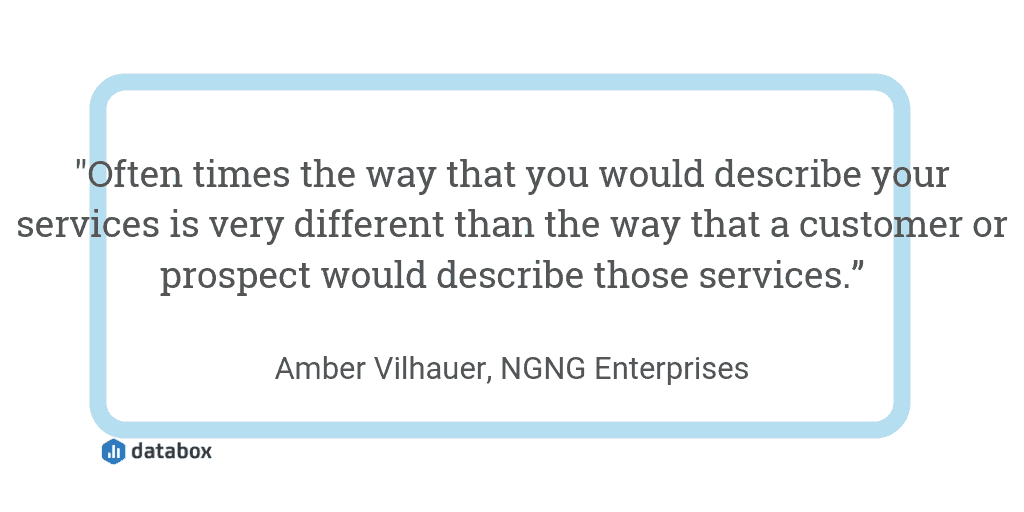
“Ultimately, people want good products that will serve them well,” Mr. SR of Semi-Retire Plan explained, “so they do have an interest in giving you helpful information to improve your —especially if they’re an existing customer who already has an affinity for your brand.”
That said, marketing consultant Farheen Gill suggests giving customers a little added incentive. “Include them in the last phase of your welcome email journeys, but also offer giveaways for other surveys you need to run throughout the year (i.e. ‘Respond today to be entered into a drawing for a $50 gift card’).”
“What’s important,” said Andrea Loubier of Mailbird, “is that you dig deep with your surveys. Asking generic questions isn’t going to get you very far. Make sure your multiple-choice questions offer diverse answers and don’t be afraid to ask the hard questions. You may be shocked at just how much your customers are willing to share.”
Louis Watton of Shiply suggested another tip for getting insightful, honest answers. “One creative approach we’ve used in customer research is not letting interviewees know the company conducting the research at first.”
Explaining, Watton added, “Often we’ve found that customers will hold back on criticism if they know you work for that company. The most valuable insights and potential improvements we’ve learned have come from asking broader questions about the industry, which allows them to talk freely without worrying about insulting anyone.”
“We launch every new survey or questionnaire with a video,” said Charles Musselwhite of FunLovingCouples. “We don’t ask any more than 12 questions at a time, and we always add in a weird and obscure question or two to keep people on their toes and engaged.”
5. Watch Customers Use Your Product
Samuel Wheeler of Inseev Interactive offered up another top-notch tip, recommending marketers actually watch customers using the product, navigating the website, interacting with content, and more.
“It’s a great idea to ask users to narrate their thought process as they navigate the page and ask them to actually take an action (purchase or form submission). In addition to asking the users to talk through their decision-making process.”
“It’s a great way to get both quantitative and qualitative data,“ Wheeler added.
If you need to understand how customers are using your product to gather feedback, one tool you should consider for customer feedback is Usersnap. This helpful tool allows product managers, software engineers, designers, and marketers to instantly collect information from users on-site through screen captures, screen recordings, surveys, feature requests, menu buttons, in-app forms, visual drawings, and bug reports.
Another feedback tool you might consider to crowdsource customer feedback and feature requests is UseResponse. This tool allows you to create feedback communities where customers can post their feedback, while others can comment and upvote it.
Pro Tip: Here Is Your Go-To Dashboard For Measuring the Performance of Your Customer Support Team
No matter your role in customer support – agent, manager, or VP – your core focus is to ensure that customers’ issues, complaints, and information requests are always dealt with promptly and efficiently. But to stay on track, you may have to spend hours manually compiling data from different tools into a comprehensive report. Now you can quickly monitor and analyze your customer service performance data from Intercom in a single dashboard that monitors fundamental metrics, such as:
- New conversations. Track the total number of new conversations your customer support team handles daily, weekly, monthly, or within the specified date range.
- Open conversations by team member. View the total number of conversations in your support inbox that are still open and find out which team members are handling them.
- Leads. Track the number of leads generated by your customer support team within a specified date range. Dig deeper to learn the nature of the messages that help convert visitors to leads, and use your insights to improve future conversations.
- Users by tag name. View the total number of conversations your customer support team has handled over time and see how your team members tagged those messages in Intercom. Using tags makes it easier for anyone monitoring the dashboard to learn more about customer needs, interests, and issues.
Now you can benefit from the experience of our customer support experts, who have put together a plug-and-play Databox template that contains all the essential metrics for monitoring and analyzing the performance of your customer support reps. It’s simple to implement and start using as a standalone dashboard or in customer service reports, and best of all, it’s free!
You can easily set it up in just a few clicks – no coding required.
To set up the dashboard, follow these 3 simple steps:
Step 1: Get the template
Step 2: Connect your Intercom account with Databox.
Step 3: Watch your dashboard populate in seconds.
6. Leverage Publicly Available Data
We talk a lot about gathering and analyzing data these days, but one thing marketers often forget about is the wealth of existing data that are publicly available online. “A lot of people overlook the incredible amount of data that the government and nonprofits collect that can be useful for customer research,” said Jeromy Sonne of Reverb Agency.
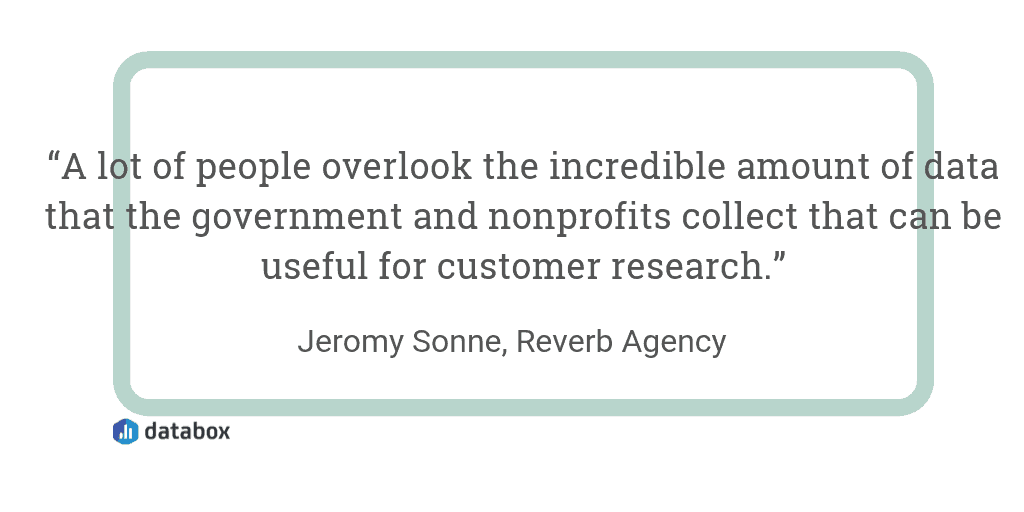
“The most creative approach I’ve used to learn more about my customers is public records, which give me additional information about the customer’s location, demographics, behavioral specialties,” added Emily Andrews of RecordsFinder. “Public records have a big database, which helps me to understand how better I can sell my clients’ goods or services.”
Carmine Mastropierro of Mastro Commerce told us about a hybrid customer research process: “One approach I’ve used to learn more about my customers is a mix of online research and market research tools.”
“Studying industry reports,” Mastropierro explained, “allowed me to get a broad overview of who my customers are and how they behave. Then, Google Analytics and other online tools helped me narrow down demographics, interests, and other behaviors to refine my audience.
7. Use Facebook Audience Insights
Casey Hill of Bonjoro also recommended pulling customer data from where it’s readily available already. In Hill’s case, that’s Facebook’s Audience Insights tool.
“It’s a free tool through Facebook,” Hill explained, “and it will give you information on any intended audience.” According to Hill, Audience Insights can help marketers answer questions like:
- What kind of jobs do customers have?
- When are they active online?
- What pages do they follow?
“It’s an incredible tool for customer research that many people aren’t aware exists.”
8. Have a One-on-One Conversation
“I find that doing a 30-minute video call beats every other type of research,” said Corey Haines of Hey Marketers. “With the right questions in hand and a friendly conversational tone, so much can be uncovered that you would never know otherwise.”
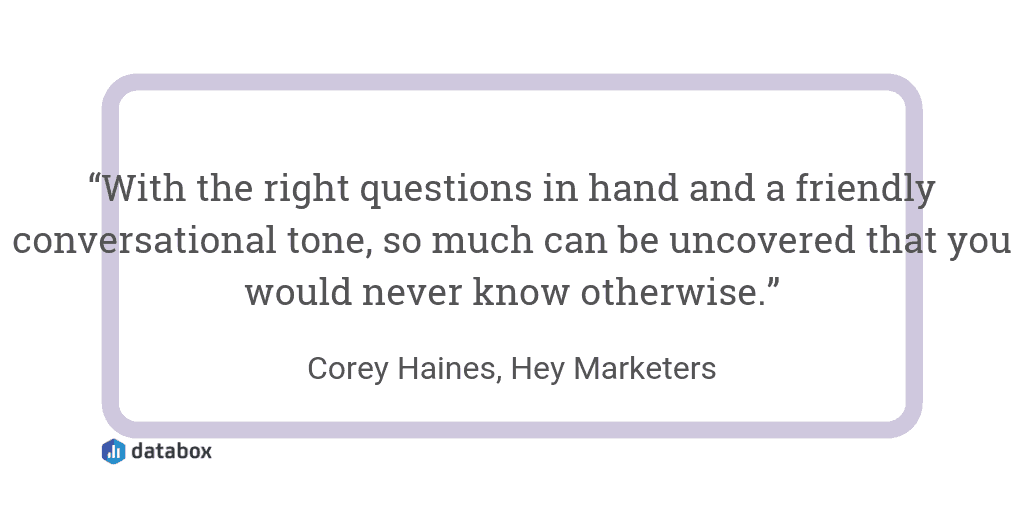
Sarah McIntyre of Bright Inbound Marketing agreed with Haines, saying, “Actually talking with people is critically important to understand, not just what they think about your product or service, but how they found you, what the sales process was like, who else they were considering, why they chose you. Unless you actually ask, you’ll be running your marketing based on assumptions.”
According to Renee Bauer, Hello Marketing Agency abides by a similar strategy for customer research. “We do regular NPS surveys for a client, and we ask responders to let us know if they are willing to participate in a one-on-one interview. These interviews serve as a helpful supplement to persona research, and provide actionable information for our client about what’s important to their current customers and how they need to improve their service.”
“Face to face encounters in a more social setting (as opposed to an interview or focus group) will give you the most honest, instinctive, and digestible feedback,” said Kyle Turk of Keynote Search.
“Online feedback methods, although they still provide great feedback, allows the user to spend too much time thinking of a response, and the ability to manipulate their responses. It also really only captures your promoters and detractors. The core customer group that is neutral about your product or service will not engage in the feedback, leaving a large gap in data.”
Anna Kaine of ESM Inbound echoed Turk, noting that “picking up the phone for a talk with customers is always more personal and genuine than just sending out a questionnaire—because you can really probe and show you’re listening. It’s a far more human experience.”
“We are clear and open about the focus of the calls, and they’re always happy to help us – after all, it’s in their best interests for us to focus closer on their pain points,” Kaine added.
Paige Arnof-Fenn of Mavens & Moguls recommended make a tour of customer interviews. “Go on a Listening Tour. Ask a few smart, open-ended questions, then sit back and take notice. Start listening with no strings attached and you’ll be amazed at what you find.”
Ever Increasing Circles’ Alistair Dodds seconded Arnof-Fenn’s last point, adding, “We’ve found out things that I don’t think would have ever come up in an office or business environment. And it’s helped us to really focus in on how to get the client to their real objective.”
9. Conduct Research With Google
It’s no surprise that the king, queen, and jester of online research is, of course, Google. But the marketers we spoke with noted so many novel ways to use Google search for customer research, including:
- Reading competitors’ customer reviews on Google My Business
- Researching the way customers speak about your product and industry
- Tailoring content toward real customer pain points and questions
“Google is an excellent resource to learn more about your customers, without the use of expensive tools,” said Ben Johnston of Sagefrog Marketing Group. “If you’re in a competitive space, look at your competition’s Google My Business profiles and read the reviews of satisfied and unsatisfied customers to learn what real customers like or don’t like about your direct competition.
Roman Zhyvitsk of Travel SEO Agency touted the importance of using Google to better understand how your customers speak about (and search for) your business. “When you sell your products or services online, it is highly important to know what search phrases people use to find it. Very often it is not as obvious as you might think.”
Johnston also noted how Google can help with ensuring content resonates with your customers, saying, “You can refine your content ideas to actually engage with your customer base by looking at ‘People Also Ask’ or ‘People Also Search For.’ That’s a direct insight into what kinds of questions your customer base is asking and what they’re interested in.”
Set Up Google Alerts for Customers and Prospects
In addition to conducting manual customer research on Google, Carlos Puig of BUNCH shared another pro tip: Google Alerts.
“Right after signing a contract with a new customer, I strongly recommend setting up a Google Alert for the name of the company and the names of the people you closed the deal with. Google will keep pushing relevant information that will help you understand the situation of your client and detect potential upsells.”
10. Ask Customers to Rate Your UX
Much of the advice we heard focused on overall customer information. But Victor Antiu of Sleek Bill says they focus on the micro aspects of customer experiences, too.
“Throughout the app, we marked micro-conversions. When the user finishes one (for example creates and sends an invoice), we show a small rating bar and based on the score he gives us, we either show him a small survey to find out what was hard, or we thank him and ask what we can improve.”
“It’s a similar system to what Skype and Booking.com do,” Antiu explained. “It’s a simple way to find pain points or issues in various funnels.”
11. Use Social Listening
“Social media is probably the best tool that you could use to understand the thought process of your client,” said Harry Gandia of Igniting Movement. “Social media can help a marketer discover what their target audience is thinking in real-time. Not many other mediums can offer that. And it’s totally free.”
Many of the marketers we spoke with invoked one form of social listening or another. After all, social media is where customers hang out—regardless of who your customers are.
Find Their Online Groups and Hangouts
“One approach we use to learn more about our customers,” Kelsey Miller of Pepperland Marketing explained, “is to find the online groups, forums, and communities that they frequent. This can be in the form of Facebook groups, Reddit threads, industry-specific forums, hashtags, and so on. This is helpful in understanding how these people interact with each other, the questions they are asking, the challenges they are facing, and so much more.”
Alexandra Sheehan of Coach Content recommends turning to Facebook Groups specifically. “I love joining Facebook groups that my audience is likely to be a part of and just observing their behavior. This shows you what really makes them tick. The things that annoy them, their true pain points, their sense of humor, little nuances like that.”
“Find out where your customers are hanging out online,” advised Vinoth AJ of Apoyo Corp, adding, “One proven method is Quora. All we have to do is type a topic and it will display all questions related to that topic. Go ahead and read all the questions related to your market.”
Create Your Own Group
While many marketers recommend going where the customers are, there’s also some benefit to taking the Field of Dreams approach.
“By far the best way to learn more about our customers has been to create a dedicated Facebook group around our products,” said Jonathan Chan of Insane Growth. “Not only does this give us the ability to foster a real sense of community around our brand, but we have routine access to the most highly-engaged members of our audience.”
Jack Paxtone of VYPER echoed Chan, explaining, “Hosting a forum either on our website or on Reddit turned out to be a great way to build a database of feedback from our clients, while also engaging with them to build a strong relationship for our brand.”
“The Vyper Facebook Group is currently our most popular platform for getting to know our customers,” Paxtone added. “We can freely interact with each other, understand their likes and dislikes, and also request valuable feedback when we are beta testing new products and services.”
Jarrod Miller-Dean of Housecall Pro added, “We utilize community outreach in our private Facebook group. For example, by posing a question in the group and asking members for their help and response.”
12. Use Heatmap Tools to Understand How Customers See Your Website
Customer research is about more than just who your customers are. It’s also about understanding how they interact with your brand and your product. That’s why Sneh Ratna Choudhary of Beaconstac recommended using a heat mapping tool to better understand and optimize their website for the customers visiting.
“We’ve been using Hotjar to understand the exact pain points of users to implement a human-centered design.”
“For instance,” Choudhary explained, “our free QR Code Generator tool was receiving visitors, but there weren’t any real conversions. We looked at Hotjar videos only to find out that we had way too many CTAs to begin with. Upon realizing this, we scaled down our CTA to include only 3 major CTAs and our visitor-to-trial conversion rate is currently hovering at 15.6%.”
13. Keep It Informal
For some, customer research can feel like a weighty, formal undertaking—but it doesn’t have to be, and many of the marketers we heard from reminded us of that.
“So many business owners and entrepreneurs think that market research is this big, complicated thing,” Carla Williams Johnson of Carli Communications pointed out. “And, while you can conduct structured surveys and questionnaires, you can also simply ask your customers directly what they think of an idea that you may have.”
“Sometimes that direct, informal approach can give you the best feedback,” Johnson added.
Liz Courtney of BBMG took that idea to the next level, saying, “To get more realistic and meaningful insight into consumers’ needs, aspirations and behavior, we try to connect with them on their own turf. Visiting them in their homes, going shopping with them, or chatting with them in pairs with a friend rather than forcing them into unnatural settings like sterile focus groups or relying only on multiple-choice surveys.”
14. Tap Your Network for Feedback
Kathleen Marrero of First Fig Marketing & Consulting emphasized the effect an existing relationship can have on the kind of customer research and feedback you end up with, suggesting your network is a great place to start.
“I have found the best way to learn more about potential customers is to open up a friendly dialogue with connections I have on social media platforms. I have reached out to numerous connections on sites like LinkedIn and asked for a real, honest conversation about whatever space I am gathering information within, the good and bad and any other information that would help me better serve the community.”
“I have found that people are very willing to offer insight if there is no sales pitch,” Marrero added.
15. Leverage Your Email Subscribers
“Reaching out to email subscribers to ask what’s bothering them is one of the most effective ways to learn more about customers,” said Priscilla Tan of Content Kapow.
“Two weeks ago,” Tan shared, “I was struggling to write a blog post. I didn’t know which topics to focus on. Rather than going with my gut, I asked my subscribers. I gave them 3 options and picked the one with the most number of votes. Not only did it help with topic development, but it also helped me to dig deeper into the pain points they’re facing at work.”
16. Offer a Beta Version of Your Product in Exchange for Feedback
One common thread throughout the responses we heard was that, while customers do have an incentive to help you create a better product for them, that isn’t always enough to entice feedback or survey responses.
To combat that problem, Carsten Schaefer of Crowdy.ai suggested offering a beta or paired-down version of your product in exchange.
“We launched a beta for 100 days before going live with our product. We gave our beta users all the features completely free in exchange for one thing: feedback about our product and how they used it for their business,” Schaefer explained. “It has brought us incredible insights which we used in the final iteration of the product.”
17. Learn from Live Chat and Support Interactions
If there’s one painfully overlooked source of customer research, it’s the support team. Few other teams within a business have the kind of direct contact with customers that customer support pros see every day.
Zack Naylor of Aurelius said, “I make it a point to answer every single live chat we get on our website for product questions and requests. Often what happens is that I get to learn a lot about potential customers from what they’re looking for and end up being able to schedule a live call to dive deeper and learn more.”
Get to Know Your Customers
Customers are the lifeblood of every successful business, and finding business traction and growth depends on your ability to get to know and understand your customers.
Whether you’re ready to go big with a large, organized customer survey or simply want to chat one-on-one with a few customers, you’ll emerge better equipped to serve their needs and grow the business.















